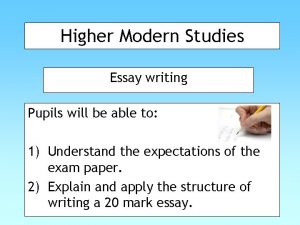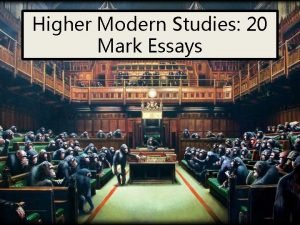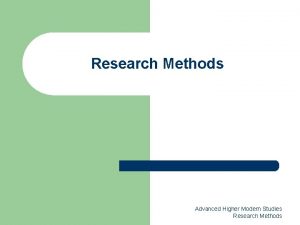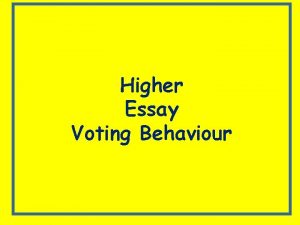Good Practice in Writing a Higher Modern Studies










- Slides: 10

Good Practice in Writing a Higher Modern Studies Essay (12 marks) Learning Intention (Pupils should be able to): • Develop good practice in writing a 12 mark Higher Modern Studies essay. That winning feeling You’ve cracked it 1

Types of 12 mark questions / What are the questions looking for? The types of 12 mark essay questions used in this paper are: �Evaluate … [12 -mark extended response] �Analyse … [12 -mark extended response] Analyse questions �Candidates will identify parts of an issue, the relationship between these parts and their relationships with the whole; draw out and relate implications. Evaluate questions �Candidates will make a judgement based on criteria; determine the value of something.

Mark Allocation for Essays (12 marks) For 12 -mark essays, up to a maximum of 8 marks will be awarded for knowledge and understanding (description, explanation and exemplification). The remaining marks will be awarded for the demonstration of higher-order skills of analysis or evaluation. Where a candidate makes more analytical/evaluative points than are required to gain the maximum allocation of 4 marks, these can be credited as knowledge and understanding marks provided they meet the criteria for this.

Mark Allocation for Essays (12 marks) contd. Answers to 12 -mark questions should demonstrate at least two relevant aspects of knowledge. For full marks (12/12), a response must include a range of points, have detailed description/explanation, include a range of accurate exemplification and analysis or evaluation. Award up to 6 marks per point. For full marks in the KU aspect of the question (8 marks), a response must include a range of points, have detailed explanation, and include accurate exemplification. Maximum of 6 marks available (from 8 for KU) if there is no accurate or relevant exemplification.


What is the difference between analysis and evaluation? An analysis infers the meaning or purpose of something; it makes an interpretation. However, an evaluation makes a judgment about the quality of something, such as an argument or decision.

Q. Analyse government policies to tackle inequalities that affect a group in society. (12) Possible approaches to answering the question: Pensioners face inequality in the UK. Some pensioners are amongst the poorest people in the UK whilst others are among the wealthiest. Government has introduced various policies to tackle these inequalities. These policies include the Pension Credit (soon to become part of Universal Credit). (2 marks KU) (2 marks, accurate point plus an example) Pensioners face inequality in the UK. Some pensioners are well off because they have savings, insurance policies and extra pensions such as occupational or private pensions, etc. Others rely on benefits like the State Pension, because they worked in low paid jobs during their working lives and did not save towards their retirement. (2 marks KU) Government has attempted to reduce some of these inequalities by introducing a variety of benefits such as the Pension Credit (soon to become part of Universal Credit). The Pensions Credit is a meanstested benefit which tops up a pensioners income to £ 148. 35, although, not all pensioners who are entitled to this benefit actually claim it. (2 marks analysis) (4 marks, two relevant points plus more extended analytical comment)

Pensioners face inequality in the UK. Some pensioners are well off because they have savings, insurance policies and extra pensions such as occupational or private pensions, etc. Others rely on benefits like the State Pension, because they worked in low paid jobs during their working lives and did not save towards their retirement. (2 marks KU) Government has attempted to reduce some of these inequalities by introducing a variety of benefits such as the Pension Credit (soon to become part of Universal Credit). The Pensions Credit is a means-tested benefit which tops up a pensioners income to £ 148. 35, although, not all pensioners who are entitled to this benefit actually claim it. Some pressure groups such as Age UK argue that the benefits forms are too complicated and that this puts off elderly people from claiming. (2 marks analysis) Pensioners also face inequalities when it comes to paying the cost of heating their homes. Pensioners are likely to spend larger portions of time in their home than younger adults. This can result in higher gas and electricity bills which, poorer pensioners receiving only benefits like the State Pension struggle to afford. (2 marks KU) Government has introduced a range of measures to try to tackle this inequality such as the Winter Fuel Payment. This is a universal benefit provided by the UK Government which gives all pensioners £ 200 - £ 300 to help with the extra costs of heating their homes in winter. Despite this help, a government study in 2010 showed that 2. 8 million pensioners were in fuel poverty in England alone. (2 marks analysis) (8 marks, two separate accurate points, with description, explanation and exemplification plus extended analytical comment)

Pensioners face inequality in the UK. Some pensioners are well off because they have savings, insurance policies and extra pensions such as occupational or private pensions, etc. (1 mark KU) Others rely on benefits like the State Pension, because they worked in low paid jobs during their working lives and did not save towards their retirement. (1 mark KU) Government has attempted to reduce some of these inequalities by introducing a variety of benefits such as the Pension Credit (soon to become part of Universal Credit). The Pensions Credit is a means-tested benefit which tops up a pensioners income to £ 148. 35, (1 mark KU/analysis) although, not all pensioners who are entitled to this benefit actually claim it. Some pressure groups such as Age UK argue that the benefits forms are too complicated and that this puts off elderly people from claiming. (1 mark analysis) Two KU points, both explained. One analysis point which, also shows KU, giving a relevant example. One extended analysis point.

Pensioners also face inequalities when it comes to paying the cost of heating their homes. Pensioners are likely to spend larger portions of time in their home than younger adults. This can result in higher gas and electricity bills which, poorer pensioners receiving only benefits like the State Pension struggle to afford. (2 marks KU) Government has introduced a range of measures to try to tackle this inequality such as the Winter Fuel Payment. This is a universal benefit provided by the UK Government which gives all pensioners £ 200 - £ 300 to help with the extra costs of heating their homes in winter. (1 mark KU/analysis) Despite this help, a government study in 2010 showed that 2. 8 million pensioners were in fuel poverty in England alone. (1 marks analysis) One relevant KU point with detailed explanation. One analysis point which, also shows KU, giving a relevant example. One extended analysis point. (8 marks, two separate accurate points, with description, explanation and exemplification plus extended analytical comment)
 Higher modern studies: 20 mark essay examples
Higher modern studies: 20 mark essay examples Modern studies 20 mark essay example
Modern studies 20 mark essay example Higher modern studies essay introduction examples
Higher modern studies essay introduction examples Advanced higher modern studies research methods
Advanced higher modern studies research methods Higher modern studies understanding standards
Higher modern studies understanding standards Importance of election essay
Importance of election essay Zoroastrianism good thoughts good words good deeds
Zoroastrianism good thoughts good words good deeds Hi good morning too.(1)
Hi good morning too.(1) Hello teacher good afternoon
Hello teacher good afternoon You are good you are good when there's nothing good in me
You are good you are good when there's nothing good in me Good morning good morning good afternoon
Good morning good morning good afternoon


















